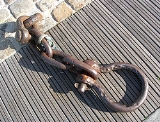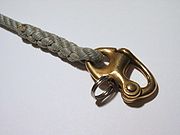
Shackle
Encyclopedia

Clevis pin
A clevis fastener is a three piece fastener system consisting of a clevis, clevis pin, and tang. The clevis is a U-shaped piece that has holes at the end of the prongs to accept the clevis pin. The clevis pin is similar to a bolt, but is only partially threaded or unthreaded with a cross-hole for a...
or bolt
Screw
A screw, or bolt, is a type of fastener characterized by a helical ridge, known as an external thread or just thread, wrapped around a cylinder. Some screw threads are designed to mate with a complementary thread, known as an internal thread, often in the form of a nut or an object that has the...
across the opening, or a hinged metal loop secured with a quick-release locking pin mechanism. They are used as a connecting link in all manner of rigging systems, from boats and ships to industrial crane rigging.
A carabiner
Carabiner
A carabiner or karabiner is a metal loop with a sprung or screwed gate that is used to quickly and reversibly connect components in safety-critical systems. The word comes from "Karabinerhaken", meaning "hook for a carbine" in German.-Use:...
is a variety of shackle used in mountaineering
Mountaineering
Mountaineering or mountain climbing is the sport, hobby or profession of hiking, skiing, and climbing mountains. While mountaineering began as attempts to reach the highest point of unclimbed mountains it has branched into specialisations that address different aspects of the mountain and consists...
.
Pin shackle
A pin shackle is closed with a clevis pinClevis pin
A clevis fastener is a three piece fastener system consisting of a clevis, clevis pin, and tang. The clevis is a U-shaped piece that has holes at the end of the prongs to accept the clevis pin. The clevis pin is similar to a bolt, but is only partially threaded or unthreaded with a cross-hole for a...
. Primarily used above the deck, pin shackles used to be the most common shackle used aboard boats. Pin shackles can be inconvenient to work with at times because they are secured using something else, usually a split pin or seizing wire.
Threaded shackle
The pin is threaded and one leg of the shackle is tapped. The pin may be captive, which means it is mated to the shackle, usually with a wire. The threads may gall if over-tightened or have been corroding in salty air, so a liberal coating of lanolinLanolin
Lanolin , also called Adeps Lanae, wool wax or wool grease, is a yellow waxy substance secreted by the sebaceous glands of wool-bearing animals. Most lanolin used by humans comes from domestic sheep...
or a heavy grease is not out of place on any and all threads. A shackle key or metal marlinspike
Marlinspike
Marlinspike is a tool used in ropework for tasks such as unlaying rope for splicing, untying knots, forming a toggle , or forming a makeshift handle....
are useful tools for loosening a tight nut
Nut (hardware)
A nut is a type of hardware fastener with a threaded hole. Nuts are almost always used opposite a mating bolt to fasten a stack of parts together. The two partners are kept together by a combination of their threads' friction, a slight stretch of the bolt, and compression of the parts...
.
For safety, it is common to mouse a threaded shackle to keep the pin from coming loose. This is done by looping mousing wire through the hole in the pin and around the shackle body. For pins that have a cross-hole in the threaded end a cotter pin can be used. One disadvantage is that mousing can introduce galvanic corrosion because of material differences; it is especially bad when used in places where the shackle is exposed to air and water.
Snap shackle

Safety harness
A safety harness is a form of protective equipment designed to protect a person, animal, or object from injury or damage. The harness is an attachment between a stationary and non-stationary object and is usually fabricated from rope, cable or webbing and locking hardware...
tether or to attach spinnaker
Spinnaker
A spinnaker is a special type of sail that is designed specifically for sailing off the wind from a reaching course to a downwind, i.e. with the wind 90°–180° off the bow. The spinnaker fills with wind and balloons out in front of the boat when it is deployed, called flying. It is constructed of...
sheets
Sheet (sailing)
In sailing, a sheet is a line used to control the movable corner of a sail.- Fore-and-aft rigs:Fore-and-aft rigs comprise the vast majority of sailing vessels in use today, including effectively all dinghies and yachts. The sheet on a fore-and-aft sail controls the angle of the sail to the wind,...
. Note: When this type of shackle is used to release a significant load, it will work rather poorly (hard to release) and is likely to have the pin assembly or the split ring fail.
D-shackle
Also known as a chain shackle, D-shackles are narrow shackles shaped like a loop of chain, usually with a pin or threaded pin closure. D-shackles are very common and most other shackle types are a variation of the D-shackle. The small loop can take high loads primarily in line. Side and racking loads may twist or bend a D-shackle.Headboard shackle
This longer version of a D-shackle is used to attach halyardHalyard
In sailing, a halyard or halliard is a line that is used to hoist a sail, a flag or a yard. The term halyard comes from the phrase, 'to haul yards'...
s to sail
Sail
A sail is any type of surface intended to move a vessel, vehicle or rotor by being placed in a wind—in essence a propulsion wing. Sails are used in sailing.-History of sails:...
s, especially sails fitted with a headboard such as on Bermuda rig
Bermuda rig
The term Bermuda rig refers to a configuration of mast and rigging for a type of sailboat and is also known as a Marconi rig; this is the typical configuration for most modern sailboats...
ged boats. Headboard shackles are often stamped from flat strap stainless steel, and feature an additional pin between the top of the loop and the bottom so the headboard does not chafe
Friction burn
A friction burn is a form of abrasion caused by friction when a person's skin rubs against a surface. It may also be referred to as "skinning", "chafing," or called by the surface which caused the burn...
the spliced eye
Eye splice
The eye splice is the best method of creating a permanent loop in the end of multi stranded rope by means of rope splicing. The ends of the rope are tucked back into the standing end to form the loop. Originally this splice was described with each end being tucked only about three times. When...
of the halyard.
Twist shackle
A twist shackle is usually somewhat longer than the average, and features a 90° twist so the top of the loop is perpendicular to the pin. One of the uses for this shackle include attaching the jibJib
A jib is a triangular staysail set ahead of the foremast of a sailing vessel. Its tack is fixed to the bowsprit, to the bow, or to the deck between the bowsprit and the foremost mast...
halyard block
Block (sailing)
In sailing, a block is a single or multiple pulley. One or a number of sheaves are enclosed in an assembly between cheeks or chocks. In use a block is fixed to the end of a line, to a spar or to a surface...
to the mast
Mast (sailing)
The mast of a sailing vessel is a tall, vertical, or near vertical, spar, or arrangement of spars, which supports the sails. Large ships have several masts, with the size and configuration depending on the style of ship...
, or the jib halyard to the sail, to reduce twist on the luff and allow the sail to set better.
Bow shackle
With a larger "O" shape to the loop, this shackle can take loads from many directions without developing as much side loadStructural load
Structural loads or actions are forces, deformations or accelerations applied to a structure or its components.Loads cause stresses, deformations and displacements in structures. Assessment of their effects is carried out by the methods of structural analysis...
. However, the larger shape to the loop does reduce its overall strength. Also referred to as an anchor shackle.

